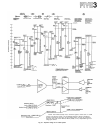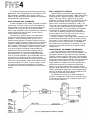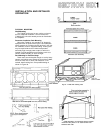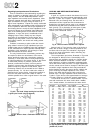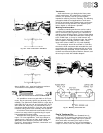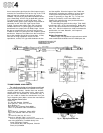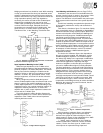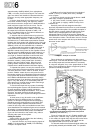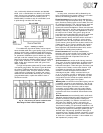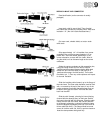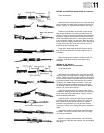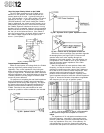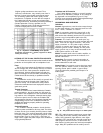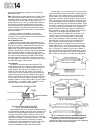
use, a cable with rubberized insulation and braided
shield
(such
as
Belden #8413 or #8412) will handle
easily and survive road abuse; for permanent wiring,
a vinyl insulated cable with a foil shield (such as
Belden #8451) is easier to strip for terminations, and
it
pulls through conduits
with
less
drag.
Fig. 47 - "Chaining" of Inputs
For unbalanced, signal level cables, use low capaci-
tance shielded cable with a good quality (high percentage
density) shield. Again, rubberized types work best for
portable use, vinyl types with foil shields are acceptable
for permanent installations (the foil shield may crack
and split under the constant flexing of portable usage).
Many single conductor shielded cables have an extremely
fragile center conductor. To avoid this problem, use a
higher quality dual conductor cable and ground one
center conductor.
For high level speaker cables and DC control cables,
use heavier gauge cable. The chart in Figure 48 shows
the effects of different sized wired gauge on power
losses in speaker cable. Except in extreme RF fields
(radio frequency interference), speaker and control
cables will not need shields; when they do, use heavy-
gauge shielded cable, or place the cables in steel or
aluminum conduit.
*Approximate. depends on wire type.
Fig. 48 - Chart showing the effects of different Sized
Wired Gauge on Power Losses in Speaker Cable.
Connectors
In
many
cases,
connectors
will
be
dictated by the
types of equipment in the system. When you can make
choices, the following guidelines may help.
Phone Connectors are an audio industry standard con-
nector used for signal and speaker lines. T.S. (tip/sleeve)
types, like those used as inputs on the P-2200, are used
for unbalanced signals; T.R.S. (tip/ring/sleeve) types are
used for balanced signals, or for stereo unbalanced
signals such as stereo headphones. Phone connectors are
generally easy to wire, and the metal types provide good
shielding. However, for high power applications, such as
the output of the P-2200, many phone plugs do not
have rated current capacities high enough to avoid some
power loss. Also, some phone plugs have a brittle
insulator between the tip and sleeve which can break if
the connector is dropped, resulting in a tip to sleeve
connection which is a direct speaker line short circuit.
For this reason, phone jacks have not been used for the
P-2200 output. If you have an amplifier with a phone
jack
output,
military
grade
phone connectors,
while
more expensive and somewhat harder to wire, are the
best choice for avoiding these problems.
Phono Connectors are not usually considered pro-
fessional, and are not included on the P-2200. If phono
connectors are part of a system, they should be the
higher quality types with a separate cover such as
Switchcraft#3502.
XLR Connectors are another audio industry standard.
They come in several configurations for different types
of cabling, and can be used for either balanced or un-
balanced connections. Three wire types, like those used
as inputs on the P-2200, are the most common. XLR
connectors are generally very durable, and are well
shielded. The three wire types have the added
advantage that pin#1 always connects before pin
#2 or #3 so that the ground or shield wire connects
before the signal carrying wires. This allows any static
charges
built
up on the shields
to
equalize before
the
signals meet, reducing pops in the system.
Banana jacks are common in the audio industry, and are
a standard connector for test equipment. They do not
provide any shield, and can be reversed in their socket.
However, banana jacks, like those used as output
connectors on the P-2200, have high current ratings,
and are good speaker connectors, especially inside an
equipment rack where occasional disconnections must
be made.
Other Connectors are occasionally used in audio work.
Standard, electrical twist-lock types have been used for
speaker connections, although there is always the
dangerous possibility of a mistaken connection to an
AC power line. Multi-pin "snake" connectors are
common for low level signals, but may be fragile and
need careful handling. For permanent installations, and
for permanent connections in portable equipment racks,
crimp type (as opposed to solder type) spade lugs and
terminal strips may actually provide the best type of
connection since a properly crimped connection is more
reliable, and lower impedance than a solder connection.
A "hard wire" or direct connection is also reliable and
low impedance if properly made.



